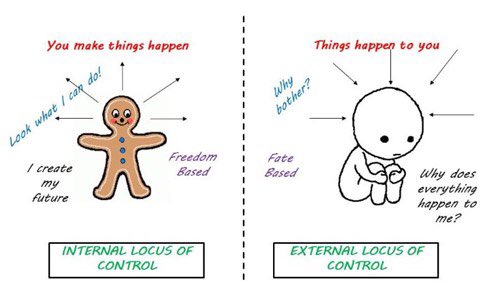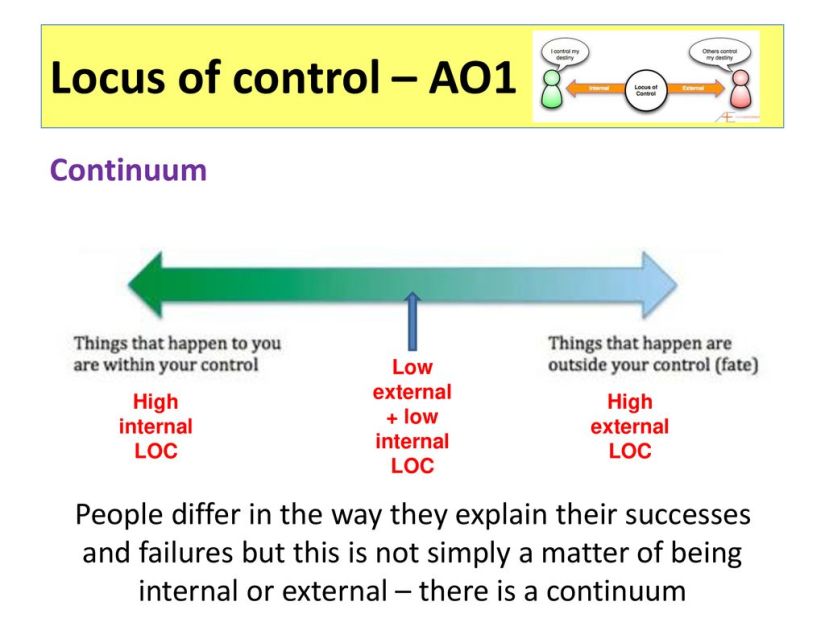Resistance to Social Change:

Rotter – Locus of Control (Dispositional Factor)


As an example imagine ‘Karthika’ does not do well in an examination. She may say that it is because she didn’t work hard enough, and should have revised more. This would mean she has an internal locus of control because she sees herself as to blame for the failure. Conversely, she could say that it was because the teacher couldn’t teach and the exam was not fair. This would suggest that she has an external locus of control and sees external reasons for the failure.

Applying LoC to resistance of social influence:
People with a high internal LoC are:
- Active seekers of information so not so likely to rely on others for information
- Achievement orientated so tend to make better leaders
- Better able to resist pressure from others


Social Support (Situational Factor)
Social Support and Conformity
Asch found that a non-conformist ally reduced conformity from a baseline 37% down to 25%. This effect remained even if the ally gave a different answer to both the other stooges and the real participant.
EVALUATION- Resistance to Social Influence: GRAVER SAUNDERS
Strengths:
- Research to Support LOC in resisting social influence: Holland (1967) found exactly this. He replicated Milgram’s research and also measured whether participants had internal or external LoC. Holland found that high internals were significantly less likely to obey in the Milgram situation (37% disobeyed) compared to only 23% disobedience for high externals. This suggests that those with external LoC are also more likely to be affected by authority figures with a high social status whereas those with an internal LoC are more likely to disobey such figures.
- Research to support the impact of social support on resisting social influence: In one of Asch’s (1951) variations, a confederate was instructed to give the correct answer throughout. In this variation the rate of conformity dropped to 5%. This demonstrates that if the real participant has support for their belief (social support), then they are more likely to resist the pressure to conform. Furthermore, in one of Milgram’s variations, the real participant was paired with two additional confederates, who also played the role of teachers. In this variation, the two additional confederates refused to go on and withdrew from the experiment early. In this variation, percentage of real participants who proceeded to the full 450 volts, dropped from 65% (in the original) to 10%. This shows that if the real participant has support for their desire to disobey, then they are more likely to resist the pressure of an authority figure. These examples increase this explanation’s scientific credibility as highly control lab experiments can demonstrate the influence that these situational factors have on a participants behaviours.
- Research to support from a real life situation: supports the idea that individuals with an internal locus of control are more likely to resist the pressure to obey. Oliner & Oliner (1998) interviewed non-Jewish survivors of WWII and compared those who had resisted orders and protected Jewish people from the Nazi’s, in comparison to those who had not. Oliner and Oliner found that the 406 ‘rescuers’, who had resisted orders, were more likely to have a high internal locus of control, in comparison to the 126 people who had simply followed orders. These results appear to support the idea that a high internal locus of control makes individuals less likely to follow orders. In addition, this research is based on a real life example of resisting social influence. Therefore, it has better external validity in comparison to Milgram and Asch’s research. On the other hand, there are many other factors that may have caused individuals to follow orders in WWII and it is difficult to conclude that locus of control is the only factor.
- Useful applications: Recent research by Twenge et al (2004) found that Americans are becoming increasingly external LoC. Between 1960 and 2002 students scored increasingly higher scores on external LoC. The researchers believe this to be bad! High external LOC is correlated with poor school achievement, depression and less self control. They believe social trends such as increased rate of divorce, increased suicide rates and mental illness could all be related to a population with an increased external LoC. By understanding this change strategies in schools and other support networks can be put in place to try and encourage the development of an internal LoC.
Weaknesses:
- Alternative Explanations: If asked to discuss or evaluate LOC or Social Support you can use the other to question it. Make sure you also bring in studies such as Asch’s variations for Social Support or Holland’s correlation between LOC and obedience.
- Supported by research that lacks Ecological validity: Asch and Milgram both lack ecological validity. They were both conducted using highly controlled conditions and standardisation which although can be beneficial when establishing cause and effect, creates problems when comparing to behaviour in the real world. In Asch’s experiment the consequences of getting a line comparison question incorrect lack the mundane realism that social consequences in the real world would have. Therefore it could be argued that the research to support the influence of social support on obedience and conformity is only applicable within the confines of an experiment and cannot be assumed to be representative of behaviour outside of this artificial setting.
- Supported by research that lacks Internal validity: The self report method can present problems with internal validity as result of participants responding in socially desirable way as opposed to what they actually think, feel or behave. It is possible that having an external LOC is more social desirable for the participants involved and as a result of being more concerned about others perceptions of them, are more likely to conform or obey. This is another explanation of social influence that could contradict the findings of the research. Therefore the difficulty in accurately assessing a participants LoC means that the theory that LoC causes an effect on resisting social influence is questionable and not a scientifically robust explanation of why people resist social influence.
- Difficulty of studying it in a valid way. Using the points above to help with this argument.
- Reductionism: For example, the Locus of control attempts to identify your type based on a questionnaire conducted at one point in time and social support is usually studied in artificial settings with a controlled independent variable (usually with social support or not) and standardized/ measured dependent variable (obedience or conformity). The methods described demonstrate how these explanations are reductionist because the way in which they study behaving is being overly simplified and condensed down into separate parts rather than considering multiple factors at a time and how they all work together.
- Application: (Challenge point only) Obedience is useful to maintaining order, therefore the impact on encouraging resistance to social influence needs to be considered before being implemented into interventions and strategies.
